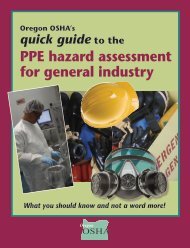Technical Manual - Section 3 (Safety Hazards)
Technical Manual - Section 3 (Safety Hazards)
Technical Manual - Section 3 (Safety Hazards)
You also want an ePaper? Increase the reach of your titles
YUMPU automatically turns print PDFs into web optimized ePapers that Google loves.
SECTION III: CHAPTER 3<br />
PRESSURE VESSEL GUIDELINES<br />
A. INTRODUCTION<br />
Recent inspection programs for metallic pressure containment<br />
vessels and tanks have revealed cracking and damage in a<br />
considerable number of the vessels inspected.<br />
<strong>Safety</strong> and hazard evaluations of pressure vessels, as also<br />
presented in PUB 8-1.5, need to consider the consequences<br />
of a leakage or a rupture failure of a vessel.<br />
Two consequences result from a complete rupture:<br />
For a leakage failure, the hazard consequences can range from<br />
no effect to very serious effects:<br />
@<br />
@<br />
Suffocation or poisoning, depending on the nature of<br />
the contained fluid, if the leakage occurs into a closed<br />
space;<br />
Fire and explosion for a flammable fluid are<br />
included as a physical hazard; and<br />
@<br />
Blast effects due to sudden expansion of the<br />
pressurized fluid; and<br />
@<br />
Chemical and thermal burns from contact with<br />
process liquids.<br />
@<br />
Fragmentation damage and injury, if vessel rupture<br />
occurs.<br />
A. Introduction.........................................III:3-1<br />
B. Recent Cracking Experience in<br />
Pressure Vessels..........................III:3-2<br />
C. Nondestructive Examiniation<br />
Methods.......................................III:3-6<br />
D. Information for <strong>Safety</strong><br />
Assessment..................................III:3-9<br />
E. Bibliography........................................III:3-9<br />
Appendix II:3-1. Recordkeeping Data<br />
for Steel Vessels and Low-<br />
Pressure Storage Tanks..........III:3-10<br />
Only pressure vessels and low pressure storage tanks widely<br />
used in process, pulp and paper, petroleum refining, and<br />
petrochemical industries and for water treatment systems of<br />
boilers and steam generation equipment are covered in this<br />
chapter. Excluded are vessels and tanks used in many other<br />
applications and also excludes other parts of a pressure<br />
containment system such as piping and valves.<br />
The types and applications of pressure vessels included and<br />
excluded in this chapter are summarized in Table III:3-1. An<br />
illustration of a schematic pressure vessel is presented in<br />
Figure III:3-1.<br />
NOTE: Though this review of pressure vessels excludes<br />
inspection or evaluation of safety release valves, the<br />
compliance officer should be aware that NO valves or<br />
T-fittings should be present between the vessel and the<br />
safety relief valve.<br />
III:3-1
















